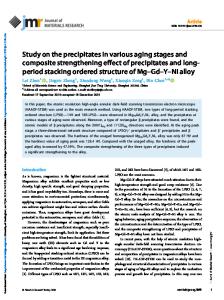A nanoindentation study on grain-boundary contributions to strengthening and aging degradation mechanisms in advanced 12
- PDF / 725,147 Bytes
- 11 Pages / 612 x 792 pts (letter) Page_size
- 69 Downloads / 320 Views
Sanghoon Shim Materials Science and Technology Division, Oak Ridge National Laboratory, Oak Ridge, Tennessee 37831; and Department of Materials Science and Engineering, The University of Tennessee, Knoxville, Tennessee 37996-2200
Shin-ichi Komazakia) and Tetsuya Honda Department of Materials Science and Engineering, Muroran Institute of Technology, Muroran 050-8585, Japan (Received 19 July 2006; accepted 25 September 2006)
Nanoindentation experiments and microstructural analysis were performed on advanced 12% Cr ferritic steel having extremely fine and complex martensitic microstructures, to answer unsolved questions on the contributions of grain boundaries to strengthening and aging degradation mechanisms in both as-tempered and thermally aged steels. Interesting features of the experimental results led us to suggest that among several high angle boundaries, block boundary is most effective in enhancing the macroscopic strength in as-tempered virgin sample, and that a decrease in matrix strength rather than reduction in grain-boundary strengthening effect is primarily responsible for the macroscopic softening behavior observed during thermal exposure.
I. INTRODUCTION
To meet the demand for efficiency improvement in fossil power plants by elevating steam temperature and pressure, some advanced heat-resistant steels have been developed with excellent mechanical performance under such severe conditions. Recently, advanced high (9– 12%) Cr ferritic/martensitic steels have received increasing attention as strong candidates for the heat-resistant materials in the ultra-super-critical (USC) power plants thanks to their superior high-temperature strengths (especially creep strength) as well as superior oxidation and corrosion resistance to conventional high Cr steels.1 These advanced high Cr ferritic/martensitic steels generally have extremely fine and complex lath-martensitic microstructures, and the excellent strengths of the steels might be attributed to the combined strengthening mechanisms of the matrix and grain boundaries, as in many other martensitic steels.2 Figure 1 schematically illustrates the microstructural parameters possibly affecting the strengthening mechanisms of advanced 12% Cr
a)
Address all correspondence to this author. e-mail: [email protected] DOI: 10.1557/JMR.2007.0009 J. Mater. Res., Vol. 22, No. 1, Jan 2007
http://journals.cambridge.org
Downloaded: 19 Mar 2015
steels. First, the matrix strength can be enhanced by intrinsic strain hardening (due to high dislocation density), solid-solution strengthening (by W and Mo), and particle strengthening (by M23C6, MX, and Laves phases). Second, grain-boundary strengthening will additionally elevate the macroscopic strength of the steels. Note that the grain-boundary strengthening discussed here is limited to conventional dislocation-based polycrystalline strengthening concept that induces Hall-Petch relation,3 and does not include the role of grain boundaries as sources of other strengthening mechanisms (e.g., as heterogeneous nuclea
Data Loading...











